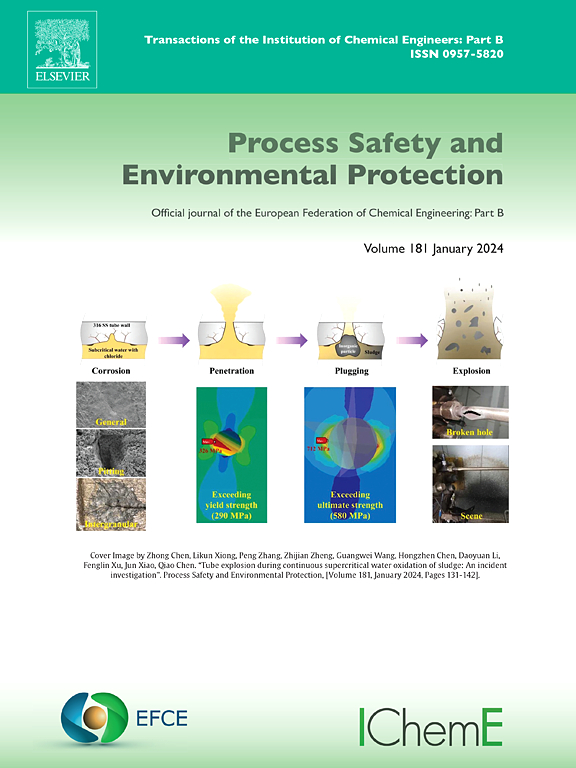Research on Coal Spontaneous Combustion Temperature Prediction Model Based on BO-LSTM
IF 6.9
2区 环境科学与生态学
Q1 ENGINEERING, CHEMICAL
引用次数: 0
Abstract
The accurate prediction of spontaneous coal combustion temperature is crucial for early warning efforts against coal fires. Nonetheless, the challenge of enhancing prediction accuracy for these temperatures persists. This paper delves into the laws governing the variation of index gases with temperature during coal's low-temperature oxidation phase. Experimental data from temperature-programmed gas chromatography of 957 coal samples were collected, and after data cleaning, 251 valid samples date were selected. Six key indicator gases were identified through correlation heat map analysis. The ratio of the training set to the test set of the valid sample data is 67%:33%, which is applied to the models BO-LSTM, LSTM-GRU, BO-XGBoost, XGBoost, M-LSTM, and NRBO-XGBoost. The results indicate that the BO-LSTM model performs well. Additionally, the hyperparameters of the LSTM model are optimized using the Bayesian optimization algorithm to avoid falling into local optima, which significantly improves prediction accuracy.Additionally, coal samples from six mines across three regions in China were selected for validation. The results indicate that the BO-LSTM model achieves an R² value of 99.6% in predicting the spontaneous combustion temperature of coal, demonstrating its exceptional performance and potential for application.基于BO-LSTM的煤炭自燃温度预测模型研究
煤炭自燃温度的准确预测是煤火预警工作的关键。尽管如此,提高这些温度预测精度的挑战仍然存在。研究了煤低温氧化阶段指标气体随温度变化的规律。收集了957份煤样的程序升温气相色谱实验数据,经数据清洗后,选出251份有效样品数据。通过相关热图分析,确定了6种关键指标气体。有效样本数据的训练集与测试集的比值为67%:33%,分别应用于BO-LSTM、LSTM-GRU、BO-XGBoost、XGBoost、M-LSTM和NRBO-XGBoost模型。结果表明,BO-LSTM模型性能良好。此外,利用贝叶斯优化算法对LSTM模型的超参数进行了优化,避免了陷入局部最优,显著提高了预测精度。此外,从中国三个地区的六个煤矿中选择煤炭样本进行验证。结果表明,BO-LSTM模型预测煤的自燃温度的R²值可达99.6%,显示了其优异的性能和应用潜力。
本文章由计算机程序翻译,如有差异,请以英文原文为准。
求助全文
约1分钟内获得全文
求助全文
来源期刊

Process Safety and Environmental Protection
环境科学-工程:化工
CiteScore
11.40
自引率
15.40%
发文量
929
审稿时长
8.0 months
期刊介绍:
The Process Safety and Environmental Protection (PSEP) journal is a leading international publication that focuses on the publication of high-quality, original research papers in the field of engineering, specifically those related to the safety of industrial processes and environmental protection. The journal encourages submissions that present new developments in safety and environmental aspects, particularly those that show how research findings can be applied in process engineering design and practice.
PSEP is particularly interested in research that brings fresh perspectives to established engineering principles, identifies unsolved problems, or suggests directions for future research. The journal also values contributions that push the boundaries of traditional engineering and welcomes multidisciplinary papers.
PSEP's articles are abstracted and indexed by a range of databases and services, which helps to ensure that the journal's research is accessible and recognized in the academic and professional communities. These databases include ANTE, Chemical Abstracts, Chemical Hazards in Industry, Current Contents, Elsevier Engineering Information database, Pascal Francis, Web of Science, Scopus, Engineering Information Database EnCompass LIT (Elsevier), and INSPEC. This wide coverage facilitates the dissemination of the journal's content to a global audience interested in process safety and environmental engineering.
 求助内容:
求助内容: 应助结果提醒方式:
应助结果提醒方式:


